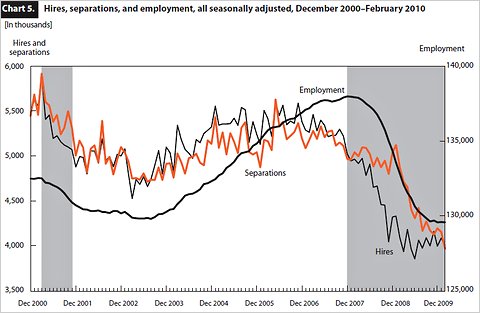
Casey B. Mulligan is an economics professor at the University of Chicago.
The recession and lack of recovery have often been characterized as a lack of hiring, rather than an extraordinary number of employer-employee “separations” (a separation is a layoff or what the Bureau of Labor Statistics calls a “quit”). But the aggregate data on hiring, quits and layoffs can be misleading.
Today’s Economist
Perspectives from expert contributors.
The chart below from the Bureau of Labor Statistics shows total hires, separations and total employment from December 2000 to December 2009. The shaded area to the right indicates the start of the most recent recession. Both separations and hires fell about 20 percent (the hires dropped sooner).
 Bureau of Labor Statistics
Bureau of Labor Statistics
However, this characterization is quite different for young people than for the rest of the work force. Even during business cycle expansions, young people have high rates of job turnover. The number of young people hired during a typical month is disproportionately high, as is the number of young people quitting or getting laid off (I use the term “layoff” to refer to both layoffs and discharges).
For this reason, young people could dominate the job turnover statistics, even while they do not dominate the employment statistics.
A paper by Michael Elsby, Bart Hobijn and Aysegul Sahin, using a method developed by my University of Chicago colleague Robert Shimer, estimated job separations for different age groups according to the number of people flowing into unemployment. They found a very different pattern for people 16-24 than they did for people 25-54.
Estimated job separations among employees ages 25-54 were 33 percent greater in 2009 than they were in 2007. I tried to update their estimates through 2010 and found that job separations still remained greater than they were in 2007.
In contrast, the low employment rates for young people since 2007 are almost entirely explained by low hiring rates.
The Bureau of Labor Statistics also reports that the composition of job separations has changed a lot since 2007. Before the recession began, quits were by far the most common type of separation; now the number of quits about equals the number of layoffs.
Perhaps the decline in quits is a signal of what’s ailing the economy, although I view it largely as a consequence of the unemployment insurance system. A person who quits his or her job is not eligible for unemployment insurance. As a result, calling a job separation a “quit” rather than a “layoff” results in the loss of unemployment benefits.
I estimate that, before the recession began, a person beginning unemployment would receive about 12 weeks of unemployment benefits, on average, if he or she were eligible for benefits. By 2010, that average was up to about 34 weeks. At $300 a week, that means that the government subsidy for calling a separation a “layoff” rather than a resignation was up to about $10,000 from $3,600.
There is also the employer payroll tax consequence of layoffs to consider, but overall employers and employees now often have a lot to gain by calling their separation a layoff rather than a quit.
These are a couple of reasons the aggregate data on hiring, quits and layoffs can be misleading. Even so, the very different patterns for people 16-24 and 25-54 may suggest that the recession and lack of recovery have more than one cause.
Article source: http://feeds.nytimes.com/click.phdo?i=8b89bed5689380d7d68af8453c8ae341
Speak Your Mind
You must be logged in to post a comment.